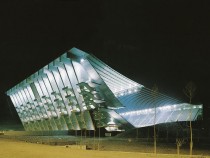
© Christian Richters
Ten stadiums were either newly built or refurbished for the European football championships in Portugal this year. Architecturally, the highlight is the stadium in Braga in the extreme north of the country. Accommodating 30,000 spectators, the arena nestles in a former granite quarry, crouching beneath the Monte Castro hills. When illuminated during night-time matches, however, it resembles a discrete, archaic piece of sculpture. Two grandstands rise steeply on the long sides of the playing field, whereas the ends remain open. From the upper part of the stands there are views over the Rio Cavado valley. The expressive east stand soars 45m above a forecourt area and is rhythmically articulated by cantilevered external staircase landings and by a series of thick concrete pier slabs at 7.5-metre centres. The circular openings in the piers form part of the horizontal circulation and afford views through the entire structure. The west stand, in contrast, is pushed up against the face of the rock, and impressive hall spaces were created in the gap between the two. Spanning between the two stands are steel cables that support the suspended roof structure: precast concrete elements on ribbed metal sheeting were laid on the cables over the seating areas. The edges facing the playing field are tied together by steel space frames that also bear the lighting and loudspeakers.







